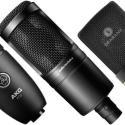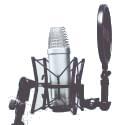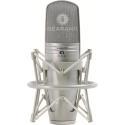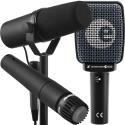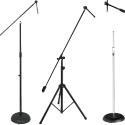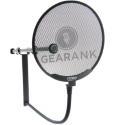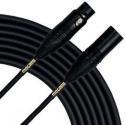Choosing the Right Type of Studio Recording Microphone for Your Vocal Type
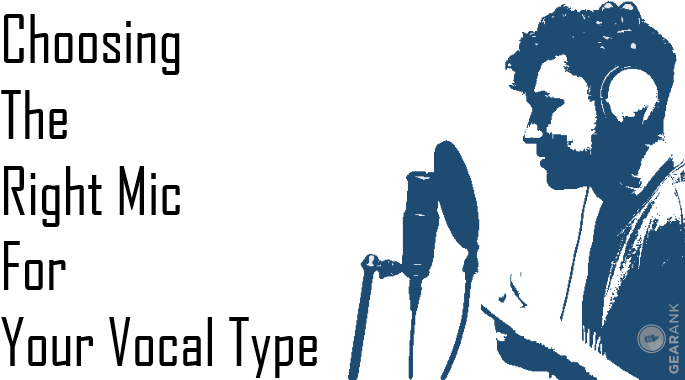
Microphones don't just pick up sound; they can also make or break your vocal recordings depending on whether they fit your singing style or not.
Everyone's voice is different: Different timbres, volumes, ranges, and textures distributed across different ages, genders and languages. That's just for the voices; microphones on the other hand have different circuitry, quality, and frequency response -- it can all get too overwhelming to even mention how each mic is different.
So how do you match two seemingly infinitely varied things with each other? Thankfully, all you need to do is get familiar with your own voice and that narrows down the choices significantly. Then it's down to choosing a mic that fits your budget and complements your vocal range and style.
Vocal ranges and textures can be hard to determine especially without coaching so for this guide I will use easier to understand terms to describe vocal types.
You should also consider your recording environment. Create a DIY vocal booth for best results.
Light and Airy Vocals
Examples: Modern, whispery pop singers like Billie Eilish, Ellie Goulding, The Weeknd (Abel Tesfaye), Charlie Puth
Lighter vocal tonalties for both male and female singers tend to have a lot of breathiness. Many cheap Condenser Mics have a high frequency boost that over-accentuates this breathiness and it can get frustrating EQ'ing them out of the track to make them fit better when mixing vocals. For this, mics with a warmer and more natural character are more desirable as extended and accentuated high frequency.
Budget: MXL V67G
The V67G is a personal favorite for its robust low end and recessed upper midrange. This smooths out breathiness while adding body to thinner sounding vocals.
Middle: Rode NT1 (not the NT1-A)
The black-bodied Rode NT1 has a warm midrange push that helps lighter vocals stand out in denser mixes It has a very upfront and intimate sound that's perfect for whispery vocals and is reminiscent of higher end microphones of German make.
High End: Neumann U 87 Ai
The Neumann U87ai is a premium microphone that specializes in natural sounding vocal reproduction. On first listen, it may appear to have a recessed midrange but the high frequencies instead have a harmonic richness that doesn't stand out versus the midrange and low frequencies. This makes it a great all rounder but particularly excels with finer vocal performances .
Neutral, Speech-Level Singing and Spoken Word/Rap
Examples: Many indie and folk singers, Speech-Level Singers, Rapping
Neutral Singing is characterized by very little effort and almost speech-like in nature. Higher notes are usually sung in falsetto to keep the energy moderate. This is the kind of singing most untrained and self-taught singers know how to do. Speech-Level Singing (SLS) is a school of singing started by Seth Riggs and is meant to be a way of singing with minimal effort and fatigue. Many SLS singers have a moderate volume throughout their entire range with their higher range barely increasing in volume but still retaining a sense of power.
Rappers, particularly those that don't put an aggressive edge to their vocals also fall into this category.
For these kinds of vocals it's best to choose mics with coloration that accentuates your vocal timbre. Be aware that some cheap condensers have a nasty sounding, brittle upper frequency lift that is different from the harmonically rich highs that well-designed mics have. You also have to consider using pop filters to prevent plosives during recording.
Budget: Audio Technica AT2020
A darling of the budget range, the AT2020 has slight upper frequency lift but keeps away from being brittle. This is great for accentuating neutral singing. Spoken word and rap are also handled fairly well thanks to how it handles transients, giving it more detail with capturing consonant sounds.
Middle: Lewitt LCT 440 Pure / Aston Spirit
The Lewitt LCT 440 Pure and Aston Spirit are two mics that seem like opposites. The LCT440 Pure has an accented upper frequency range, a neutral midrange and a slight low frequency lift. The Aston Spirit on the other hand is more midrange frequency focused.
The LCT440 Pure is great for voices that need to sound detailed and intimate while the Spirit benefits those that want their vocals to be more upfront thanks to its midrange push.
High End: Neumann TLM 102 / AKG C414 XLS
Both of these microphones are famous for their great treble harmonics that give vocals a polish that cheaper mics often fail to replicate. The TLM 102 has a slightly more neutral midrange compared to the pulled back midrange of the C414.
Similar to how the Lewitt and Aston compare against each other, The TLM 102 is better for those looking for an upfront sounding microphone while the AKG C414 XLS is for those that need a mic that blends well with less dense instrumentals.
Operatic, Belting, Screaming, and other Loud and Aggressive Singing Styles
Examples: Punk/Extreme Metal Vocals (screamed and yelled), Classic Rock/Metal singers, Opera singers and singers that frequent the higher vocal range with a lot of power
While not as common as the previous two singing styles, these powerful and loud styles require microphones with high dynamic range and SPL handling on top of having a frequency range that prevents them from sounding too harsh in the mix. If your choosing between Dynamic vs Condenser Mic for vocals, here are some tips: For screamed vocals, Dynamic Mics are often the best choice while soaring belted singers may want a condenser that doesn't push the harsh 2kHz peak of these vocals too much.
Budget: Shure SM58, Shure SM57 (With A81WS windscreen) / AKG P120
It's no secret in the metal recording community that many aggressive vocals are recorded with dynamic mics. The classic Shure SM58 and its sibling the SM57 are longtime studio staples for recording these kinds of vocals. There are even "hacks" for the SM57 to sound closer to a Shure SM7b by adding the Shure A81WS foam. I have this combination and it does sound closer to the SM7b albeit with slightly less high frequency finesse.
For those that want a condenser for belting, the AKG P120's 150dB max SPL with pad is great for soaring vocals without overloading the capsule or componentry.
Middle: Shure SM7b / Rode NT1-A
The Shure SM7b is a surprisingly great microphone for screaming and yelling punk/metal vocals. Its high SPL handling and balanced frequency range makes these vocals fit exceptionally well in heavy mixes. Producers like Joey Sturgis cite it as their go-to mic for aggressive vocals.
For Condensers, The Rode NT1-A has a bit more high end than the NT1. This gives belted vocals a great, brass-like quality or "twang" as some vocal coaches put it.
High End: Electro Voice RE20 / Neumann TLM 103
The Electro-Voice RE20 has been a staple for rap vocals for a long time. Aggressive rap vocals shine because of how the RE20 handles the proximity effect thanks to its Variable-D tech.
The Neumann TLM 103 is also a great pick for louder singers thanks to its wide dynamic range. Singers that go from quiet to belted notes benefit greatly from this.
Conclusion
While there are still so many other styles of singing out there, these encompass a majority of singing styles. If you have and questions for your specific singing style, feel free to drop a comment below and I will try to point you in the right direction.
About the Author
Raphael Pulgar
I've been an audio engineer for 20 years specializing in rock and metal recordings. I also play guitar and produce original music for my band and other content creators.
Media
Main/Top Image: Produced by Gearank.com.
The video has been embedded in accordance with YouTube's Terms of Service.



